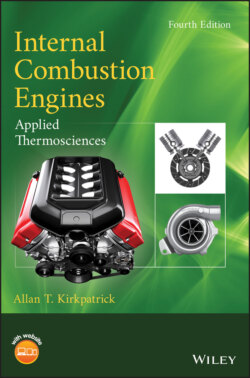Читать книгу Internal Combustion Engines - Allan T. Kirkpatrick - Страница 20
Mean Effective Pressure
ОглавлениеThe mean effective pressure (mep), defined in Equation (1.14), is the work done per unit displacement volume. It is the average pressure that results in the same amount of work actually produced by the engine and has units of force/area. The mean effective pressure is a very useful parameter as it scales out the effect of engine size, allowing performance comparison of engines of different displacement.
(1.14)
There are three useful mean effective pressure parameters – imep, bmep, and fmep. The indicated mean effective pressure (imep) is the net work per unit displacement volume done by the gas during compression and expansion. The name originates from the use of an 'indicator' card used in the past to plot measured pressure versus volume. The pressure in the cylinder initially increases during the expansion stroke due to the heat addition from the fuel, and then decreases due to the increase in cylinder volume.
The brake mean effective pressure (bmep) is the external shaft work per unit volume done by the engine. The name originates from the brake dynamometer used to measure the torque produced by the rotating shaft. Typical values of bmep for vehicular engines depend on the load. A low‐load bmep is about 5 bar, a mid‐load bmep is about 10 bar, and a high‐load bmep is about 20 bar. Use of turbo‐ or supercharging is generally required to produce a high‐load bmep.
Based on torque, the bmep is
(1.15)
and in terms of power, the bmep is
(1.16)
The bmep can also be expressed in terms of piston area , mean piston speed , and number of cylinders :
(1.17)
The friction mean effective pressure (fmep) includes the mechanical engine friction, the pumping losses during the intake and exhaust strokes, and the work to run auxiliary components such as oil and water pumps. Accordingly, the friction mean effective pressure (fmep) is the difference between the imep and the bmep. Determination of the fmep is discussed further in Chapter 10.
(1.18)
The bmep of two different displacement naturally aspirated automobile engines at wide‐open throttle (WOT) is compared versus mean piston speed in Figure 1.8. Notice that when performance is scaled to be size independent, there is considerable similarity.
Figure 1.8 Brake mean effective pressure at WOT versus mean piston speed for two automotive engines.
